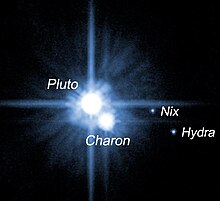冥卫二
 新视野号于2015年7月14日所拍摄到的冥卫二 | |
| 发现 | |
|---|---|
| 發現者 | 哈勃空间望远镜 Pluto Companion Search Team |
| 發現日期 | June 2005 |
| 編號 | |
| 命名依據 | Nyx |
| 其它名稱 | (134340) Pluto II[1] |
| 形容詞 | Nictian |
| 軌道參數[2] | |
| 半長軸 | 48708 km |
| 離心率 | 0.002 036 ± 0.000 050 |
| 軌道週期 | 24.854 63 ± 0.000 03 d |
| 軌道傾角 | 0.195° |
| 隸屬天体 | 冥王星 |
| 物理特徵 | |
| 大小 | 49.8 x 33.2 x 31.1 km[3] |
| 質量 | 5×1016 to 2×1018 kg[4] |
| 平均密度 | 1.37 g/cm3 |
| 自轉週期 | 1.829 ± 0.009 d (chaotic) |
| 轉軸傾角 | 132° (variable) |
| 反照率 | 0.04–0.35 (assumed)[5] |
| 溫度 | 33–55 K |
| 視星等 | 23.38–23.7 (measured)[5] |

冥衛二正式名稱為Nix(/ˈnɪks/ ,尼克斯),是冥王星的一颗卫星。
2005年5月首次被冥王星伴侣搜索隊通过哈勃太空望远镜观测到。其照片于2005年5月15日和2005年5月18日被哈勃望遠鏡拍摄到;2005年5月15日Max J. Mutchler经确认和预估後,于2005年10月31日公布卫星发现的消息,初被編號為S/2005 P2,於2006年6月下旬的國際天文學聯合會會議上正式被命名為Nix(尼克斯,希臘神話中代表黑夜的女神)(原本建議命名為Nyx,但是為了不和小行星3908(Nyx)混淆,所以把它命名為與Nyx同音的Nix),名字以2006年1月啟程飛往冥王星的新视野號(New Horizons)探測器名字的首個字母為概念。
观测显示其与冥卫一(卡戎)类似,軌道半徑49,000公里,以25天周期繞冥王星運轉;估計其直径在31-50公里之间(依反照率判定将可研判出更精确的数据)。冥衛二比冥衛三暗25%,所以可能也比较小。
初時研究時認為冥衛二和冥王星一樣是紅色的,後來才發現冥衛二和其他兩顆衛星一樣是灰色的。
根據觀察,冥衛二並沒有穩定的自轉(自轉一週大約1.829天)。
參見
[编辑]參考資料
[编辑]- ^ Jennifer Blue. Gazetteer of Planetary Nomenclature. IAU Working Group for Planetary System Nomenclature (WGPSN). 2009-11-09 [2010-08-30]. (原始内容存档于2007-07-26).
- ^ Showalter, M. R.; Hamilton, D. P. Resonant interactions and chaotic rotation of Pluto’s small moons. Nature. 2015-06, 522 (7554): 45–49 [2021-12-06]. ISSN 0028-0836. doi:10.1038/nature14469. (原始内容存档于2022-05-13) (英语).
- ^ Weaver, H. A.; Stern, S. A.; Mutchler, M. J.; Steffl, A. J.; Buie, M. W.; Merline, W. J.; Spencer, J. R.; Young, E. F.; Young, L. A. Discovery of two new satellites of Pluto. Nature. 2006-02, 439 (7079): 943–945 [2021-12-06]. Bibcode:2006Natur.439..943W. ISSN 0028-0836. PMID 16495991. arXiv:astro-ph/0601018
 . doi:10.1038/nature04547. (原始内容存档于2022-05-13) (英语).
. doi:10.1038/nature04547. (原始内容存档于2022-05-13) (英语).
- ^ Based on the range of diameters from Buie et al. (2006), and densities ranging from 1 g/cm3 (ice) to 2 g/cm3 (Pluto).
- ^ 5.0 5.1 Stern, Daniel; Chary, Ranga-Ram; Eisenhardt, Peter R. M.; Moustakas, Leonidas A. Spitzer Observations of the Prototypical Extremely Red Objects HR 10 and LBDS 53W091: Separating Dusty Starbursts from Old Elliptical Galaxies. The Astronomical Journal. 2006-09, 132 (3): 1405–1414 [2021-12-06]. Bibcode:2006AJ....132.1405S. ISSN 0004-6256. arXiv:astro-ph/0607507
 . doi:10.1086/506347. (原始内容存档于2021-12-06) (英语).
. doi:10.1086/506347. (原始内容存档于2021-12-06) (英语).
外部链接
[编辑]- IAU Circular No. 8625 关于发现的描述
- 关于冥王星新发现的两颗卫星的背景信息 – discoverers网站
- [1] (页面存档备份,存于互联网档案馆)
| ||||||||||||||||||||||||||||||||||||||||||||||||||||||||||||||||||||
| ||||||||||||||||||||||||||||||||||||||||||
Text is available under the CC BY-SA 4.0 license; additional terms may apply.
Images, videos and audio are available under their respective licenses.


